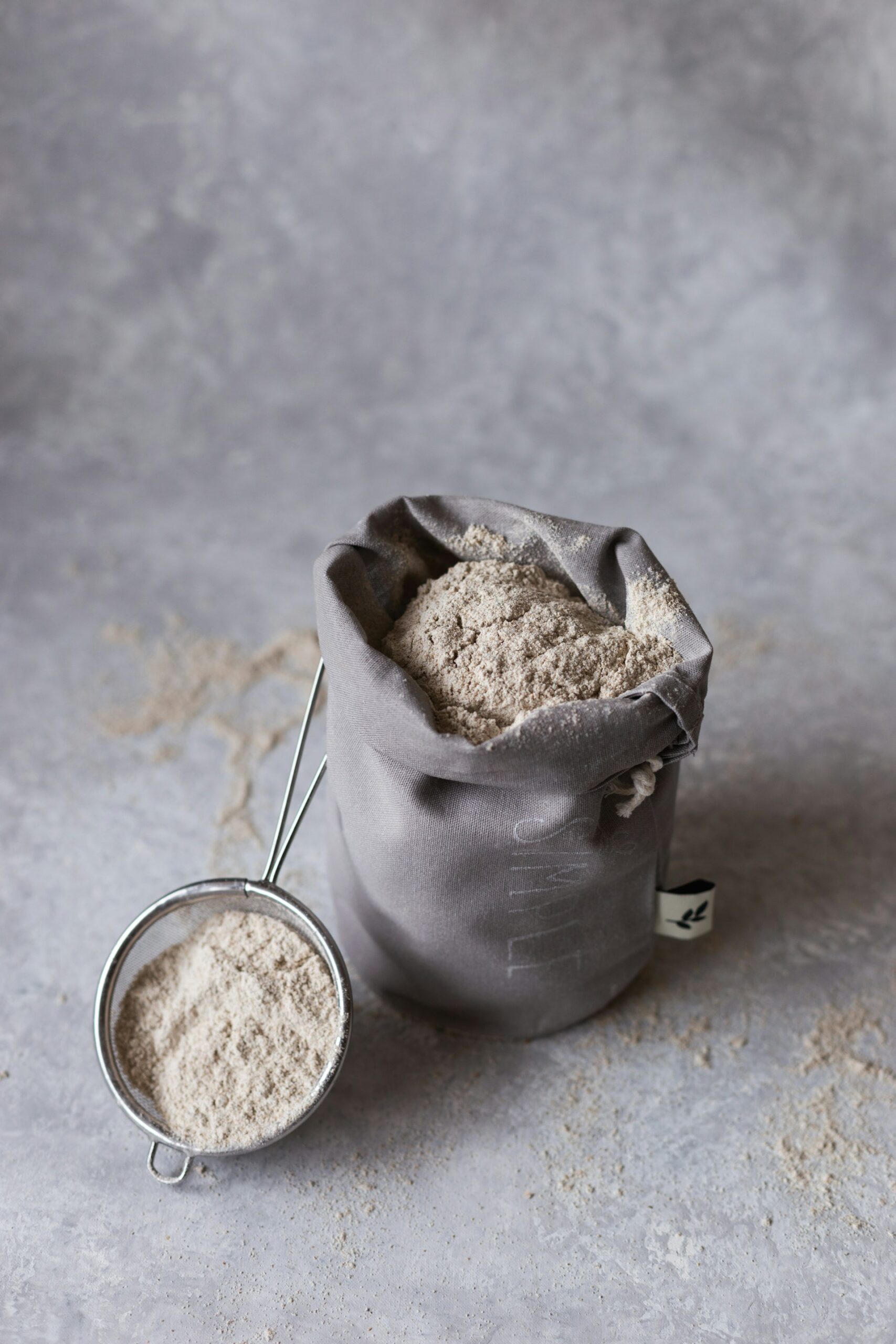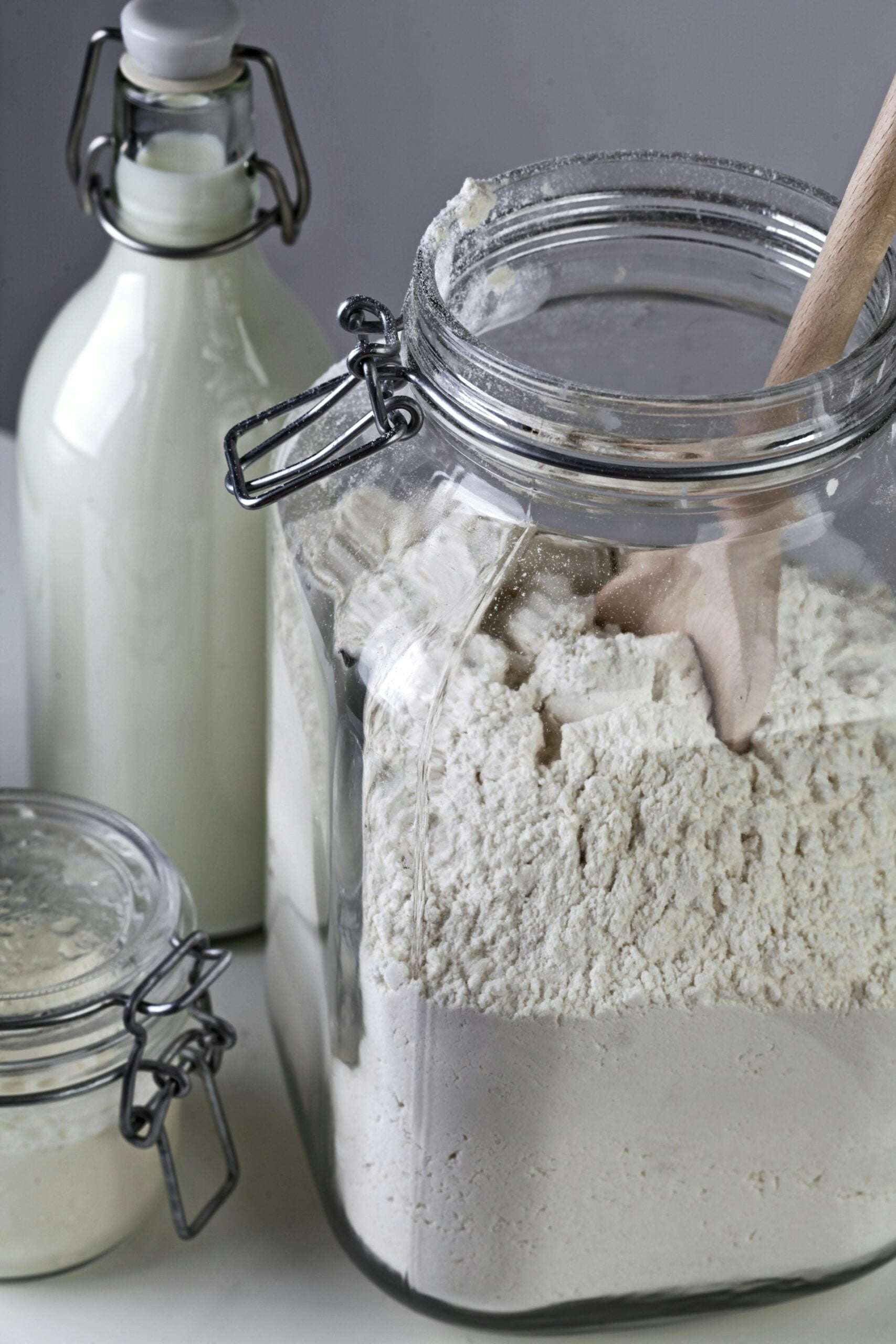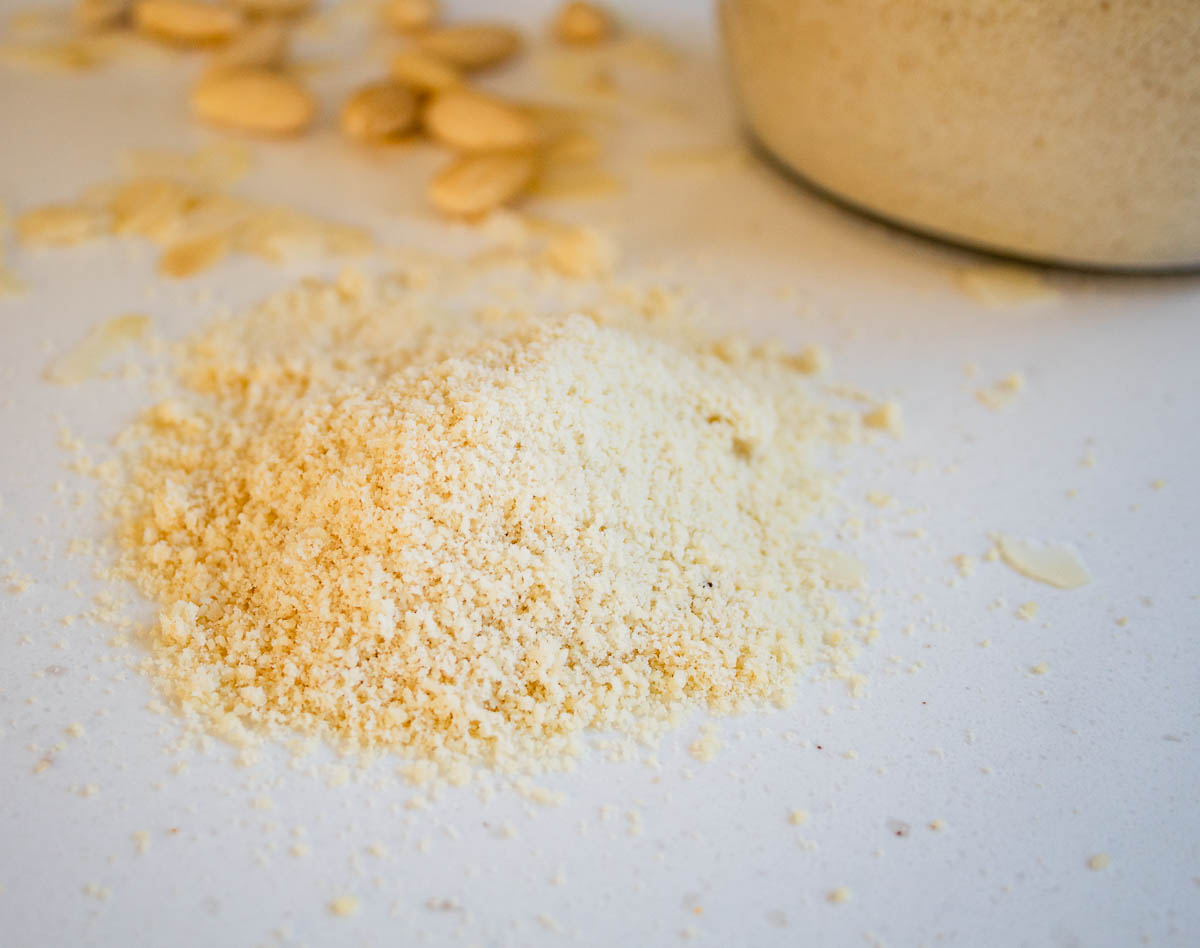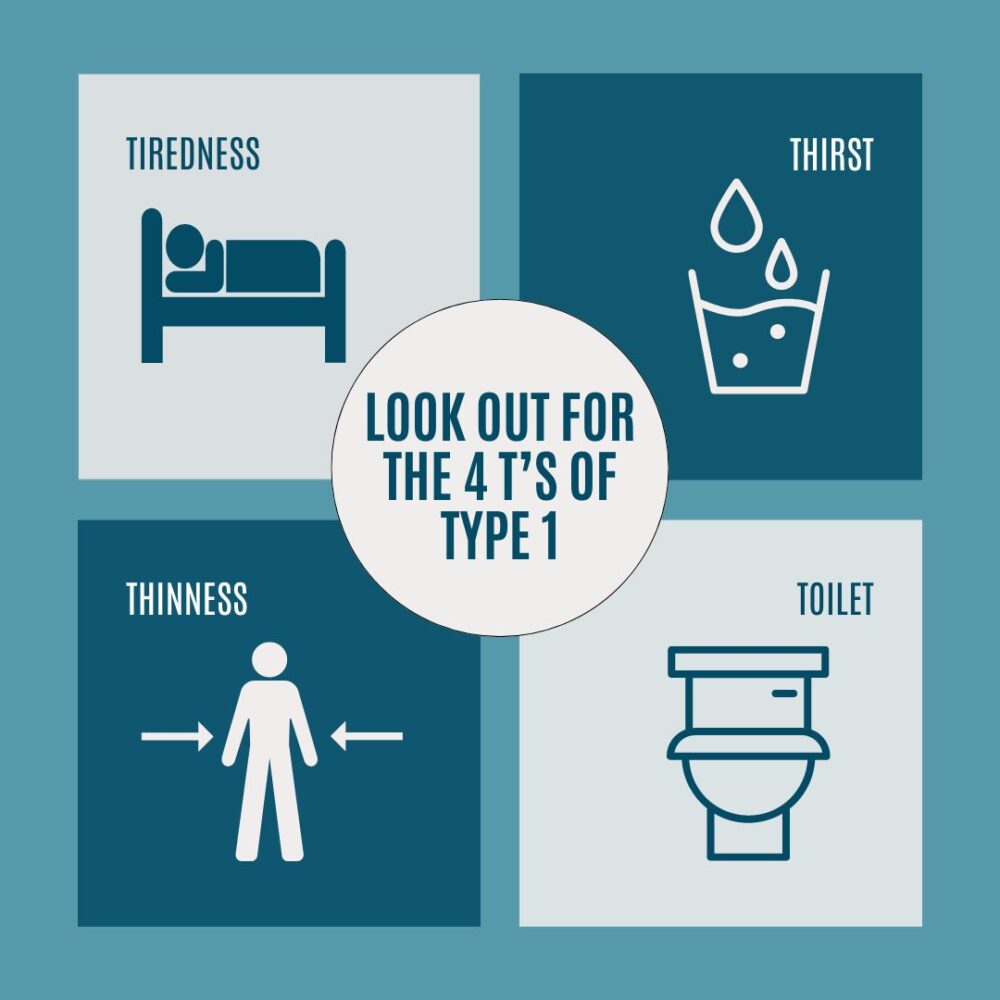Exploring the Impact of High vs. Low Glycemic Index of flour on Blood Sugar Management is an important part of getting to grips with understanding your diabetes. Read on to understand what the glycaemic index is and which flours can help support better blood sugar management.

Understanding the profound impact of glycemic index and load on diabetes management is the key focus of this article, particularly from the perspective of a mum of a type 1 diabetic child like me. I aim to shed light on the critical role that flour plays in blood sugar control, offering insight into the best low glycemic index (GI) flours and their benefits for diabetes management. By exploring the glycemic index of various flours, I hope to equip you with valuable knowledge to make informed choices when it comes to managing blood sugar levels through diet, especially in the context of diabetes.
In this guide, we delve into what the glycemic index is, the different high, moderate and low GI flours and their effects on blood sugar levels, to provide you with more insights.
Key Takeaways
- Understanding the impact of glycemic index and load on diabetes management is helpful for effective blood sugar control.
- Different types of flour can significantly influence blood sugar levels and offer other health benefits
- Low-GI flours are a great option to better support your overall diabetes management.
- Understanding THE Glycemic Index (GI) and Glycemic Load (GL)
- Why Flour Type Matters
- High Glycemic Index Flours
- Moderate Glycemic Index Flours
- Low Glycemic Index Flours
- Understanding Resistant Starch in Flour
- Tips for Selecting and Using Moderate to Low GI Flours
- Understanding the Impact of the Glycemic Index of Flour
- References and more information
Understanding THE Glycemic Index (GI) and Glycemic Load (GL)
The Glycemic Index measures the effect of a specific food on blood sugar, ranking it on a scale of 0 to 100. The scale measures how quickly a food raises blood glucose levels. Foods with a high GI (70 and above) cause rapid spikes in blood sugar. While those with a low GI (55 or less) lead to more gradual, steady increases.

Glycemic Load looks at the GI value of food along with the amount of carbohydrates in the portion or serving size. The GL can provide a more comprehensive understanding of its impact.
The Usefulness of GI & GL
Studies on individuals living with type 2 diabetes tend to indicate that opting for low GI foods can be beneficial for regulating long-term blood glucose levels, (HbA1c & time in range). But, as always there is limited evidence regarding its impact on individuals living with type 1 diabetes. However, from experience, we have certainly found that selecting low-GI foods as part of a balanced diet does help us avoid sudden spikes and experience steadier blood glucose levels post-meal.
Low GI and low GL foods are really helpful as part of your diabetes management toolkit. They can support a significant reduction in high blood sugars, reduce insulin resistance, and lower the risk of cardiovascular diseases. Although arguably this could be because they are often unprocessed, whole foods high in dietary fiber and essential nutrients!
Nevertheless, understanding these concepts can empower you to make informed decisions about the foods you choose, especially in selecting appropriate flours for maintaining optimal blood sugar control. There is more information in the resources section below if you would like to read more.
The Limitations of the Glycemic Index
While the glycemic index (GI) can be a useful tool for understanding how different foods affect blood sugar levels, it’s essential to recognise its limitations and potential inaccuracies:
- Variability in GI Values: GI values can vary depending on several factors, including ripeness, processing, cooking methods, and food combinations. This variability can lead to inconsistencies in predicting the actual impact of a food on blood sugar levels.
- Individual Response: GI values are determined based on the average response of 5-10 healthy individuals. But individual responses to foods can vary widely. When it comes to blood glucose there are many other factors to also take into consideration. Factors such as genetics, hormones, gut microbiome, and insulin sensitivity can all influence how a person’s body responds to carbohydrates. This makes GI values less reliable.
- Incomplete Picture: GI values only consider the impact of a single food on blood sugar levels. They do not account for portion sizes or overall dietary composition like the inclusion of fat, fibre and protein. Also eating foods with a low GI in excessive amounts can still lead to spikes in blood sugar levels, especially if combined with high-GI foods.
- Focus on Carbohydrates: GI values primarily focus on carbohydrate-containing foods, which may not provide a complete picture of a food’s overall nutritional quality. Some foods with a low GI, such as certain processed snacks, may still be high in unhealthy fats, sugars, and additives, negating potential benefits.
Why Flour Type Matters
Flour type matters for diabetes management and knowing the glycemic index (GI) value, can help with this. Foods with a high GI cause rapid spikes in blood sugar, while those with a low GI result in slower, more gradual increases. Consuming high-GI flours, such as refined white flour or corn flour, can lead to sharp increases in blood sugar levels. Continual high blood glucose levels can contribute to long-term complications associated with diabetes. On the other hand, choosing low-GI flour, such as almond flour or coconut flour, can help stabilise blood sugar levels supporting better glycemic control.
Furthermore, low-GI flours often contain higher levels of fibre and nutrients compared to their high-GI counterparts. Which means additional health benefits such as improved digestion, satiety, and overall nutritional intake. Therefore, understanding and selecting the right type of flour for you can not only help to maintain optimal blood sugar levels, but also support overall health and well-being.

White Flour vs Whole Wheat Flour
White vs. Whole wheat is often a big discussion point. Particularly around which is healthier and better for blood sugar management. Whole wheat flour is generally considered healthier than white flour due to its higher nutritional content, including fibre, vitamins, minerals, and antioxidants. With its lower glycemic index, whole wheat flour promotes steadier blood sugar levels and better glycemic control, making it particularly beneficial for individuals with diabetes. However, white all purpose flour may be preferred for certain types of baking due to its lighter texture and milder flavour. Nevertheless, I would always opt for incorporating some kind of whole wheat into your diet whenever possible. Balancing your intake of refined grains (such as white flour) with whole grains (such as whole wheat flour) is another way you can reap the nutritional benefits of both.
High Glycemic Index Flours
Flours with a high glycemic index (70-100) can cause rapid spikes in blood sugar levels after consumption. This is because they are quickly broken down into sugar in the body during digestion, leading to a sudden release of glucose into the bloodstream.
Common high-GI flours include:
White flour: GI ranging from 70 to 85 – high GI food
Also known as refined flour or all-purpose flour, is a finely processed powder derived from wheat grains, where the outer bran and germ are removed. This refining process results in a fine texture and light colour, making white flour suitable for lots of baking and cooking
White flour is high in carbohydrates and lacks the fibre, vitamins, minerals, and antioxidants present in whole grains, causing it to be rapidly digested and resulting in a sharp increase in blood sugar levels.
Corn flour: GI ranging from 55 to 70 – moderate GI food
Also known as maize flour, is a fine powder made from dried corn kernels. It is a versatile flour and gluten-free ingredient, which can be used as a thickener and adds flavour & texture. Corn flour is relatively low in fat and protein but contains a moderate amount of carbohydrates. It also provides essential nutrients such as vitamin A, vitamin B6, folate, and magnesium. However, compared to whole grains like whole wheat flour, corn flour typically has less fiber and fewer vitamins and minerals and is more likely to spike blood glucose levels.
White rice flour: GI ranging from 70 to 87 – high GI food.
A finely ground powder made from milled white rice grains. It is commonly used in gluten-free cooking and baking as it is naturally free from gluten, making it suitable for individuals with celiac disease or gluten intolerance. It has a mild flavour and smooth texture, ideal for delicate baked goods such as cakes, cookies, and pancakes. However, as it is refined to be a high GI food it will have a fast impact on raising blood sugar levels

Moderate Glycemic Index Flours
These flours in our experience require insulin but have less of a profound and fast impact on blood sugars. They tend to have a slower more steady impact.
Common moderate GI flours include:
Oat Flour: GI ranging from 55 to 65
Made from ground oats, it is rich in soluble fibre, and healthy fats which form a gel-like substance in the digestive tract, slowing down the absorption of carbohydrates and reducing the glycemic response. Oat flour is particularly effective at promoting fullness and satiety, making it beneficial for blood sugar management.
Whilst it has a moderate GI value the high content of dietary fibre may slow down the absorption of glucose into the bloodstream, making it respond more like a low GI flour. Oats are definitely slow burners on my daughter’s blood sugars and we love them for that slow steady energy release.
Spelt Flour: GI ranging from 54 to 63
An ancient grain flour derived from the spelt plant, a distant cousin of modern wheat. It is rich in nutrients, including protein, fibre, vitamins, and minerals. It contains essential nutrients such as iron, magnesium, phosphorus, and B vitamins. While spelt does contain gluten, some individuals with gluten sensitivities find it easier to digest compared to modern wheat due to differences in protein composition. It has a slightly nutty flavour and a slightly sweet taste, which adds depth and texture to baked goods and other dishes.
Wheat Flour: GI ranging from 54 to 69
A nutritious flour made by grinding the entire wheat kernel, including the bran, germ, and endosperm. Compared to refined white flour, whole wheat flour contains more fibre, vitamins, minerals, and antioxidants. This helps to slow down the digestion and absorption of carbohydrates, resulting in a lower glycemic response. However, it’s essential to note that the exact GI value of whole wheat flour can vary depending on factors such as the specific variety of wheat used, the milling process, and individual differences in glycemic response.
Low Glycemic Index Flours
Flours with a low glycemic index (GI) have a gradual impact on blood sugar levels after consumption, leading to better glycemic control. These flours typically contain more fibre, protein, and healthy fats, which slow down the digestion and absorption of carbohydrates.

Here are some common low-GI flours and their effects on blood sugar levels:
Almond Flour: GI ranging from 0 to 10
Almond flour is made from finely ground almonds. It has a low GI due to its high fibre, high protein and healthy fat content. With its nutty flavour, it is an excellent flour alternative for individuals seeking low-carb flours. Which is why it is one that I use in most of my baking now as it is diabetic carb-count free. It provides a steady release of glucose into the bloodstream, promoting sustained energy levels and helping to stabilize blood sugar. Read more about baking with almond flour and my 20 favourite recipes
Chickpea Flour: GI ranging from 28 to 45
Also known as garbanzo bean flour, it is made from ground chickpeas (or garbanzo beans. It is a good source of protein, fibre, and complex carbohydrates. The lower GI compared to refined flour, provides sustained energy, helping to regulate blood sugar levels. It also provides other essential nutrients such as iron, magnesium, potassium, and B vitamins. Additionally, chickpea flour is gluten-free, making it suitable for individuals with gluten intolerance or celiac disease. With its nutty flavour and dense texture it is used in a variety of savoury recipes. Chickpea flour can be used as a thickening agent in soups & sauces too.
Coconut Flour: GI ranging from 45 to 50
Derived from dried coconut meat, it contains approximately 60-70% dietary fibre, making it one of the most fibre-rich flours available. Additionally, it is gluten-free, grain-free, and low in carbohydrates, great for individuals with diabetes, gluten intolerance, celiac disease, or those following a low-carb or ketogenic diet. Coconut flour has a naturally sweet and nutty flavor, with a fine texture similar to wheat flour. It absorbs moisture exceptionally well, which can result in denser baked goods. Due to its high fibre content, recipes using coconut flour may require additional liquid ingredients. You may need more eggs, milk, or water or instead, use a mix of flours so the end result is not too dry.
Buckwheat Flour: GI ranging from 50 to 54
Made from ground buckwheat groats and is highly nutritious, containing a good amount of protein, fibre, vitamins, and minerals. It is particularly rich in magnesium, manganese, copper, and phosphorus. Buckwheat flour is also naturally gluten-free, making it suitable for individuals with celiac disease or gluten sensitivities. It has a distinctive nutty flavour and a slightly earthy taste, which adds depth and texture to baked goods.
Brown Rice Flour: GI ranging from 50 to 55
Made from whole grain brown rice, which retains the bran and germ layers, providing added fibre, vitamins, and minerals. It is used in heartier baked goods like bread and muffins, offering a nuttier flavour and denser texture. It has a lower GI compared to white rice flour, helping to stabilise blood sugar levels over time.
Understanding Resistant Starch in Flour
It is a type of starch that resists digestion in the small intestine, therefore having a minimal impact on blood sugar levels, as it is not readily broken down. This can help stabilise blood sugar levels and reduce the risk of insulin resistance.
Notably, flours naturally higher in resistant starch, also offer numerous health benefits. These are whole grain flours like whole wheat, brown rice, and oat flour, alongside legume-based flours like chickpea and lentil flour. They offer better blood sugar control, increased satiety and potential improvements in heart health.
Tips for Selecting and Using Moderate to Low GI Flours
I moved away from using high GI flours predominantly in my baking after my daughter was diagnosed with type 1 diabetes and made the switch to using a combination of moderate to lower GI flours.
Here are a few of my top tips that I recommend when selecting and using low GI flours in cooking and baking:
- Read the Labels: Read labels carefully to identify low GI options, flour mixes and if it is a requirement, whether it’s gluten-free.
- Mix and Match: Experiment with combining different low GI flours in recipes to achieve different textures and flavours. For example, blend almond flour with coconut flour or whole wheat flour with oat flour to create nutritious and delicious baked goods. Alternatively, check out my sweet treat recipes which use a combination of moderate to lower GI flours.
- Include Protein and Fiber: Incorporate additional sources of protein and fibre into recipes using low GI flour. Adding ingredients such as nuts, seeds, eggs, Greek yoghurt, fruits, and vegetables can further reduce the overall glycemic load of the dish and enhance its nutritional value.
- Mindful Baking Techniques: Be mindful of baking techniques that can affect the glycemic index of baked goods. Also consider using alternative sweeteners like xylitol, or mashed fruits instead of refined sugars. Read my comprehensive guide on baking with Almond Flour to help you too.
- Use as Thickening Agents: Low GI flours can also be used as thickening agents in soups, stews, sauces, and gravies. Alternatives such as chickpea flour or brown rice flour add flavour and nutrition while helping to achieve the desired consistency.
- Portion Control: Portion matters when consuming foods made with low GI flours. While these flours may have a lower impact on blood sugar levels compared to refined flours, consuming large portions can still result in significant carbohydrate intake and affect blood sugar levels.
Understanding the Impact of the Glycemic Index of Flour
By understanding the impact of high and low glycemic index flours on blood sugar levels, you can make informed choices to support better blood sugar management and overall health. Incorporating low-GI flours into your diet can be a simple yet effective step towards achieving optimal blood sugar control.
As a type 1 diabetes carer, I understand the impact that glycemic index and load can have on blood sugar levels. Despite its limitations incorporating low-GI options into daily meals, allows you to make positive changes in managing diabetes through diet. So empower yourself as well by exploring the diverse range of alternative flours, incorporating them into your daily meals, and reaping the health benefits they offer.
References and more information
- American Diabetes Association. (n.d.). Glycemic Index and Diabetes. https://www.diabetes.org/glycemic-index-and-diabetes
- Harvard T.H. Chan School of Public Health. (2020). The Nutrition Source – Carbohydrates and Blood Sugar. https://www.hsph.harvard.edu/nutritionsource/carbohydrates/carbohydrates-and-blood-sugar/
- Glycaemic index and diabetes. https://www.diabetes.org.uk/guide-to-diabetes/enjoy-food/carbohydrates-and-diabetes/glycaemic-index-and-diabetes
- Glycemic Load. https://www.diabetes.co.uk/diet/glycemic-load.html
- Glycaemic Index (GI) – https://www.bda.uk.com/resource/glycaemic-index.html
- Glycemic index and glycemic load: measurement issues and their effect on diet-disease relationships – 2007 https://pubmed.ncbi.nlm.nih.gov/17992183/
- Glycemic index, glycemic load, and chronic disease risk—a meta-analysis of observational studies 2008 – https://www.sciencedirect.com/science/article/pii/S0002916523235315
- The glycemic index of foods: a physiological basis for carbohydrate exchange – 1981 https://www.sciencedirect.com/science/article/abs/pii/S000291652342816X?via%3Dihub
This article aims to provide comprehensive insights into the relationship between flour types, glycemic index, and blood sugar management. For more personalised advice, consult with a healthcare professional or registered dietitian.










Leave a Reply